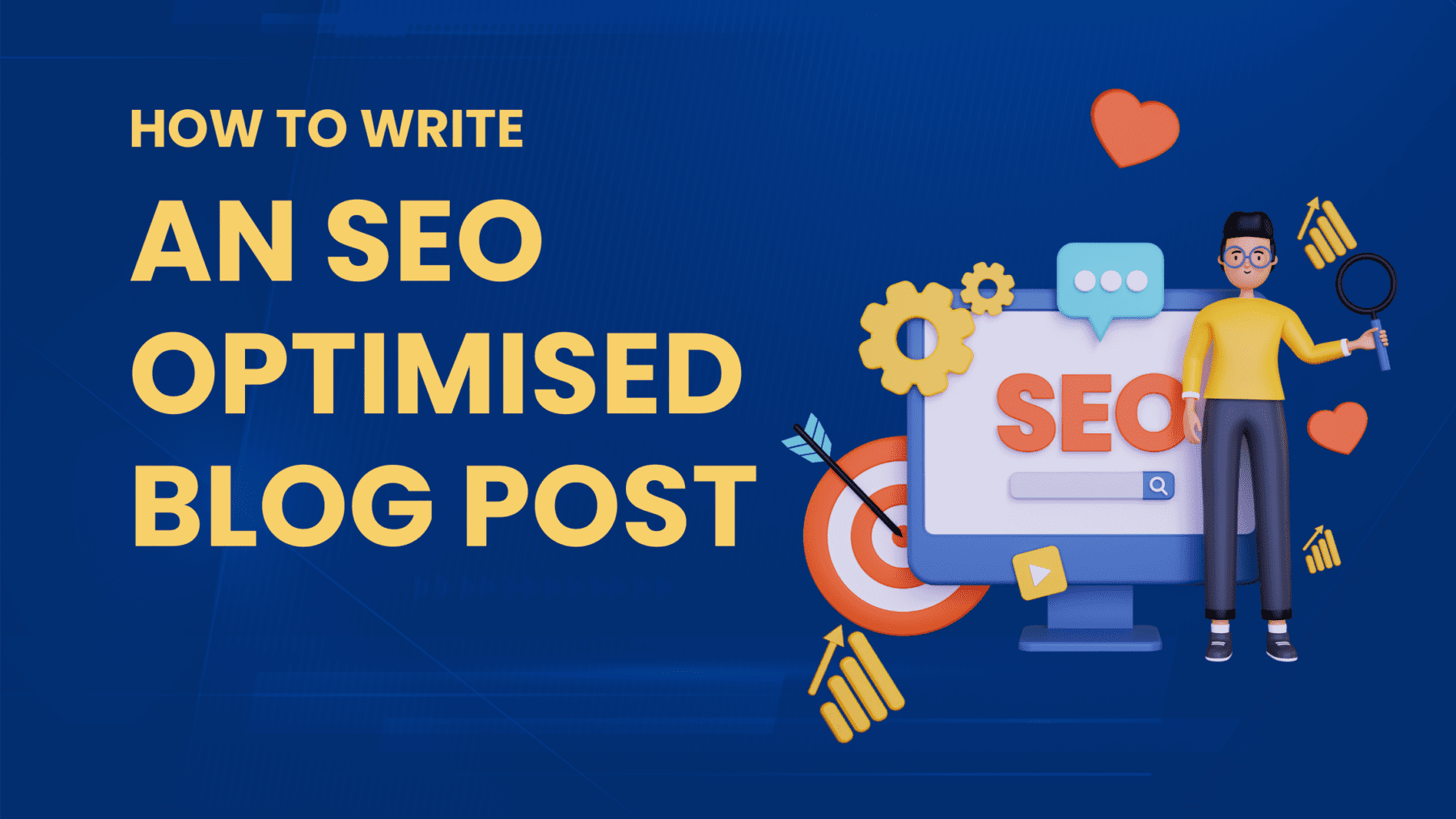How to Write an SEO Optimised Blog Post
Do you want to know how to optimise blog posts for SEO? You’ve come to the right place as you will discover how to master your blog SEO.
Optimising blog content is a common dilemma faced by content writers and marketers alike. Many content writers fall into the trap of fixating solely on search engines that neglect human readers. It’s one of the most common mistakes when writing a blog post.
The most successful search engine optimisation strategy has to be a balance of writing for the search engine and the people – your target audience. At least, that is what you need to do if you want to build your blog audience and keep a consistent flow of traffic to your website.
Before you discover the secret to optimising blog posts for search engines, you need to understand the basics of SEO copywriting which will help you create relevant content for both your audience AND search engines.
Write for People, Not Search Engines
To succeed with blog SEO, you have to factor in Google search results and elements that could affect your blog performance. However, you must not forget about your audience or the people who will be reading your content.
Even if you optimise blog posts and reach the top of the Google search results page, it’s no use if the visitors read your new blog post and don’t find the content that they were looking for. It will increase your website’s bounce rate, but will also hurt your SEO strategy.
Instead, you must focus on writing for people first and then incorporate all the keywords you want to target naturally. Your blog post should also focus on achieving two main goals:
- Appeal to your target readers
- Offer a solution to their pain points
If you achieve that, you can move on to the next step, which is to employ SEO tactics that will get your content on top of the search result page. You must create content that offers value and considers the information that your audience wants to learn about. When you provide your readers with a valuable and helpful article, it will increase engagement and they will be more likely to come back to your website to read more articles in the future. This technique will help boost your organic traffic performance in the long run.
Benefits of Blog Posts for SEO
Does blogging help with SEO? The short answer is yes.
When you optimise your blog, it boosts your search engine optimisation performance by positioning your website as one of the authoritative sources of information relevant to their Google search. You can also optimise your own blogs to maximise your ranking page SEO performance using various SEO tactics and content strategies.
Investing time and efforts in building SEO-friendly blogs for your website is essential as it will come with many benefits, including:
Targeting the right audience
You can include relevant keywords in your blog posts. The beauty of using blog posts as part of your SEO strategy is that you can target different types of audiences and keywords in your blog content. Therefore, you can discuss topics that are trending or popular in order to boost your organic traffic. You can insert those keywords when you produce content for your blog to deliver valuable content that your readers will be able to easily find on Google.
Boosting the visibility of your website on Google
There are plenty of opportunities to enrich blog posts with relevant keywords. Therefore, it also gives search engines more opportunities to crawl through the content and suggest it for a relevant search, based on the target keyword. According to Hubspot, using blog posts and updating your own blogs regularly will give you up to 55% more visitors.
Supporting your link outreach strategy
Link building is an important part of an effective search engine optimisation strategy. The more inbound links are pointing to your website, the better it is to improve your SEO performance. Adding external links to authoritative sources can boost your website ranking while also adding credibility to your blog content. At the same time, building valuable content on your blog site will encourage other websites to link back to yours. It will not only boost your credibility but also expand your audience reach and attract new potential customers to your website.
Keeping your website content updated and relevant
Outdated or inactive content can hurt your website’s SEO performance. If your blog posts are not updated, it makes people wonder if your business is still operational. On the other hand, the search engine algorithms will be unable to find updated information to refer to web users so your blog posts won’t be included in the Google search rankings, which will have a negative impact on your organic traffic.
Optimising blog posts
for SEO makes visitors spend more time on your website. It is known as dwell time. While dwell time is an indirect ranking factor on Google search engines, it is a measure of a positive user experience. A positive user experience will boost your search engine results ranking. This metric tells Google that people are liking the content on your website and finding it useful and valuable since they are spending more time on your website.
Keyword Research
Keyword research is the heart and soul of boosting your blog SEO performance and getting it ranked higher on the search results page. Good blog content offers value and useful insights into specific topics to the readers. However, good blog content that uses a target keyword, as well as relevant ones, makes it easy for your audience to find that content on the search engines.
One of the most common mistakes that SEO beginners make is to guess what topics to write about, as well as the long-tail keywords to use. But if you want your content to achieve a positive outcome, you cannot rely on blind guesses to deliver the results you want.
First, you need to use a reliable keyword research tool. You can use this tool to identify the top-performing long-tail keywords or keyword phrases to focus on. It also provides you with a list of all the keywords that you can incorporate into the content, which can be related to the primary keyword. The goal is to target the keywords that the user searches on Google search engines and provide them with valuable content that will answer any questions they might have when typing these keywords.
Once you identify the relevant keywords for your blog content, you can incorporate a few keywords into your blog post, but it’s crucial to avoid keyword stuffing. Keyword stuffing is the process of inserting as many keywords into the blog post as possible. This approach to using keywords can have a negative impact on your SEO strategy, as well as your blog SEO performance.
Keyword stuffing is any unnatural insertion of a keyword phrase in the hopes to optimise blog content. Indeed, using too many keywords in relation to the length of the article can indicate to Google that you are attempting to trick the search engine algorithm. As a result, these types of SEO tactics rarely work because the quality and value of content are diminished.
Ideally, you have to pick a focus keyword and then a few other relevant, long-tail keywords. Sprinkle the focus keyword and relevant keywords throughout the article. The content strategy to use here is called keyword distribution. Make sure you have keywords in the introduction, the body, and the concluding paragraphs. This approach ensures that your blog is SEO-friendly.
How to Optimise Blog SEO
Now that you understand the importance of developing an SEO-friendly blog and keyword research, the next step is to optimise blog posts for SEO. The following are the essential blog SEO tips that you must consider when writing blog posts to increase the amount of blog traffic to your website.
1. Optimise the Blog Post Title
The post title is the first thing that people will see about your blog. Therefore, you need to work on writing an effective and impactful blog post title that incorporates your focus keyword and is catchy enough to capture the readers’ interest.
There are several elements present in an SEO-friendly blog post title. Obviously, the primary keyword should be there. It should be used creatively so that readers have an idea of what the blog content is about and what they can expect to find when they read it.
A good blog post title must incorporate numbers. For example, The Top 5 Coffee Shops in New York as Recommended by a New Yorker.
Another element of a good post title is to include a teaser. For example, We Tried the New Lipstick from [Brand]: Here’s Our Honest Review.
Lastly, you can include an offer (if applicable) to your post title to make it more intriguing. For example, 5 Tips for CV Writing + A Free Template.
Like the keyword research tool, you can also use tools to analyse your blog title. If you don’t have access to one, just remember the elements mentioned above to write an effective blog post title that is optimised for SEO.
The main point when writing an optimised post title for your blog content is to think about what your audience wants and to give it to them. It takes a good understanding of your target market to develop a good content strategy or write content that appeals to them.
2. Break Down Content into Headings
The use of headings serves many purposes for your blog post.
First off, it makes your blog posts easier to read because the information is broken down into sub-categories. It organises your content into different categories so you can focus on one sub-topic at a time. This structure makes it easier for your website visitors to read and understand the content, which in turn makes the content valuable to the readers.
Second, it helps to optimise your blog posts because you can target keywords in your subheadings. Search engine crawlers will look at these headings and determine what topic you are talking about for each section. It is a great way to generate blog traffic from search engines.
And lastly, it makes your blog post scannable. Instead of writing a few long paragraphs, it becomes easier to manage the content through shorter and segmented paragraphs.
3. Devise a Structure for the Blog
Readability is an important factor for search engine rankings. Make sure that you follow a definitive structure for your blog post to improve readability.
The ideal structure of a blog post includes an introduction, a body, and a conclusion. You must incorporate related keywords into each section to optimise blog posts for the search engine.
The introduction is where you give an overview of the main topic of your blog post. It’s important that you let your audience know right away what your content is about.
The body is where you will discuss the topic in detail. Break down the body of the blog post into several, short paragraphs. Keep your sentences short, too, so they will be easier to read.
Finally, add a conclusion to your blog post. Avoid the practice of ending your blog posts abruptly as it’s not very engaging for the reader. Summarise the main ideas you presented. The conclusion is also where you can insert your call-to-action (CTA) message, which is to visit your website, read other blogs, etc.
4. Optimise Content for Featured Snippets
Featured snippets are the short yet relevant information taken from your blog post that Google displays on top of the search results page. The snippet also includes a link to your blog post. Since the featured snippets appear on top of Google search engine page, it is a great way to boost blog traffic.
However, your content will be chosen only if it is well-optimised with your target keyword and if the content is relevant to the search query.
To earn that feature, you must answer the questions relevant to the search query succinctly and briefly. Also, use actionable verbs when writing your post to make it easier to follow.
The ideal length for the featured snippet is 58 words. Therefore, keep your answers to this length to be able to qualify for the feature on Google search results.
5. Use Focus Keyword & Relevant Keywords
Keyword stuffing is a frowned-up SEO practice. When you incorporate long-tail keywords into your blog posts, make sure they flow naturally and are relevant to the context of the information.
Avoid keyword stuffing as it can hurt your SEO strategy more than it helps. To avoid stuffing, use semantic keywords or synonyms. Google is smart enough to identify the related keywords and phrases in your content. Therefore, there is no point in over-optimising your blog SEO. It definitely won’t generate more traffic to your website.
6. Optimise Meta Descriptions
Add a meta description to optimise blog posts for the search result page. A meta description is a short description that succinctly describes what the blog post content is about for the search engine algorithm. The character limit is 155 characters; you can exceed the character limit but it will be cut short when Google displays your meta descriptions.
Using meta descriptions will improve your search engine rankings if you optimise it with the relevant keywords. It is also the short featured snippet that will appear on Google when your blog post shows up as one of the search results for a relevant query.
7. Add Images and Videos to Your Blog Posts
Images and videos make your blog posts more engaging and visually appealing. Also, website visitors love visual content as they are easier to consume. Adding images and videos to your blog can help support your informative article and boost your search engine rankings.
For the images, you can use stock images, infographics, image galleries, and tutorial images to support the information in your blog content. The use of images also helps to break up longer posts and make them scannable.
Optimise your blog by adding images and incorporating alt texts to those images. Alt text can be a keyword phrase or any phrase that briefly describes what is on the image. Alt texts are good to make your blog post accessible, which is one of the new ranking factors on Google. Optimizing your images with effective image SEO techniques can significantly impact your website’s discoverability and help you stand out from competitors in search results.
Aside from images, you can add videos to your posts, where relevant. Videos are as engaging as images. It is beneficial for blog SEO because it makes the content easier to digest and makes the blog post more dynamic. If you have a Youtube channel, you can embed those videos in your blog post so that you can also promote your channel.
8. Optimise the Blog Length
Long form blogs are now the goal for many bloggers and content writers because Google favours comprehensive blog posts. Search engines love content that covers topics in great detail. If you want to optimise your blog posts, consider the ideal length for your blog.
According to experts, your blog content must be at least 300 words. However, Google likes long articles that have comprehensive information. Therefore, aim to write content that is as long as it takes to cover the essential information for your chosen topic.
The goal is to look for a balance. You don’t want your blog posts to be too short that it lacks value. At the same time, it should not be too long to scare your users away or bore them.
There are no right or wrong answers as to the ideal length of a blog. The best way to approach this is to focus on making an SEO-friendly blog. Incorporate your keywords naturally throughout the text and break them up into smaller paragraphs using headings.
The right structure and a natural flow of information will make your blog post interesting to read, no matter how short or long it is.
9. Internal & External Linking (But Keep it Relevant)
Links are vital to search engine optimisation. It is one of the most important ranking factors for blog posts. If you want your blog to reach the top of the search engine, make sure to add as many relevant links as possible.
The first tip is to add internal links or those links that point to other pages within your website. Internal linking builds a contextual relationship between your old and new posts, while also gaining readership for your old posts. Furthermore, internal linking helps to keep your website visitors on the site. The more time they spend on your website, the better it is for your SEO performance.
Internal linking is one of the best practices for on page SEO. Therefore, make it a part of your content strategy, too.
Aside from internal links, you should also add links to authority and external websites. Make sure that you add links only when necessary or where it adds value. Linking your blog to these authority websites can add to your credibility and reputation.
10. Optimise Blog Posts for Mobile
There are a growing number of web users that access the internet on their mobile devices, such as tablets and smartphones. It’s important that you optimise your blog posts for mobile devices as it also helps with your blog SEO performance.
Don’t waste those valuable queries on mobile devices to help with generating organic traffic to your blogs. Since the Penguin update on Google, the algorithm on search engines is now favouring mobile-friendly websites.
It’s important to build a responsive website design that makes it easily accessible on any device. Therefore, it will make your blog posts’ search engine rankings higher and place them on top of the search results page.
11. Update Your Posts Regularly
Once you hit the ‘Publish’ button on your blogs, your work does not end. If you want to optimise blog posts, you have to update them regularly. There are a few things you can do to boost the performance of your published blog on the search results page.
First off, you can share old blog posts with your readers. It is important to encourage new visits and shares to your blog posts. Another way is to update the content of the blog. If it’s been a while since you last published it, you can update it with new and relevant information to ensure that your readers get fresh information from your blog posts.
It is also essential to keep track of the Google Analytics data to see how well the post is doing. Use Google Analytics insights to improve blog post performance and boost search rankings. One way to do that is to link to this published post from other relevant blog posts, or you can add external links to other authority sources. You can also perform internal linking to point to other pages that have relevant information to support the published content.
These search engine optimisation strategies can significantly improve the search rankings performance of published blog posts.
12. Use an SEO Plugin
An SEO plugin is an analysis tool that is available on a WordPress site or some other content management systems. The purpose of using a plugin is to check if you optimise your blog posts well enough.
The plugin will consider various aspects of your blog SEO using your target keyword. It will check your copy, meta descriptions, blog title, alt text, and URL, to make sure that you optimise blog posts. This automated tool is easy to use because it tells you when your post is SEO-friendly or not. It can also suggest changes to improve your optimisation of the blog post.
13. Employ a User-Friendly URL Structure
Google search engines also examine your URL structure for your blog to determine what the topic is about and if it is relevant to a search query. The URL is one of the first things that search engine crawlers look at.
Therefore, you must not forget to optimise the URL for every blog post. It’s also important for each post to have a unique URL. If possible, incorporate your primary keyword phrase into that URL.
Conclusion
Long gone are the days when black hat SEO tactics can get you at the top of the search result page on Google. With the recent algorithm updates on Google, quality content is king.
However, an SEO-friendly blog is even better so that you can deliver a helpful article to human readers and also optimise your blog posts so they can be found on the search engine. You must implement the blog SEO tips above to increase website traffic and get more readers to discover your blog!










Leave a Comment